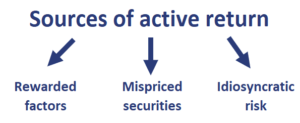Sources of Active Return
Active returns generally come from three sources; rewarded factors, exposures to mispriced securities, and idiosyncratic risk. On this page, we discuss each of these sources of active return. We also discuss the formula that can be used to perform a decomposition of realized (ex post) active return. But let’s first discuss where active returns can come from.
Three sources of active return
Active returns can come from:
- the level of strategic long-term exposure to rewarded factors. Rewarded factors are risks that are widely accepted as offering long-term positive risk premiums (e.g. market beta, size, value, liquidity,…)
- Tactical exposures to mispriced securities, sectors, and rewarded risks that generate alpha (return that cannot be explained by long-term exposure to rewarded factors). Alpha is directly related to manager skill.
- Idiosyncratic risk (from concentrated active positions) that generates returns related to luck. It is labeled luck in the sense that it is not due to market risk exposure or value-added alphat
Active return formula
The decomposition of realized (ex-post) active return can be done using the following formula
where betapk is the sensitivity of the portfolio to each rewarded factor k, betabk is the sensitivity of the benchmark to each rewarded factor k, Fk is the return of each rewarded factor, and (alpha + epsilon) is the return not explained by exposure to rewarded factors. Alpha is the active return attributable to manager skill and epsilon is the idiosyncratic return (luck or noise). In practice it is very hard to distinguish between skill and noise.
Summary
We discussed the three sources of active return that each fund manager will play in a different way to try and generate active returns for his or her clients.

